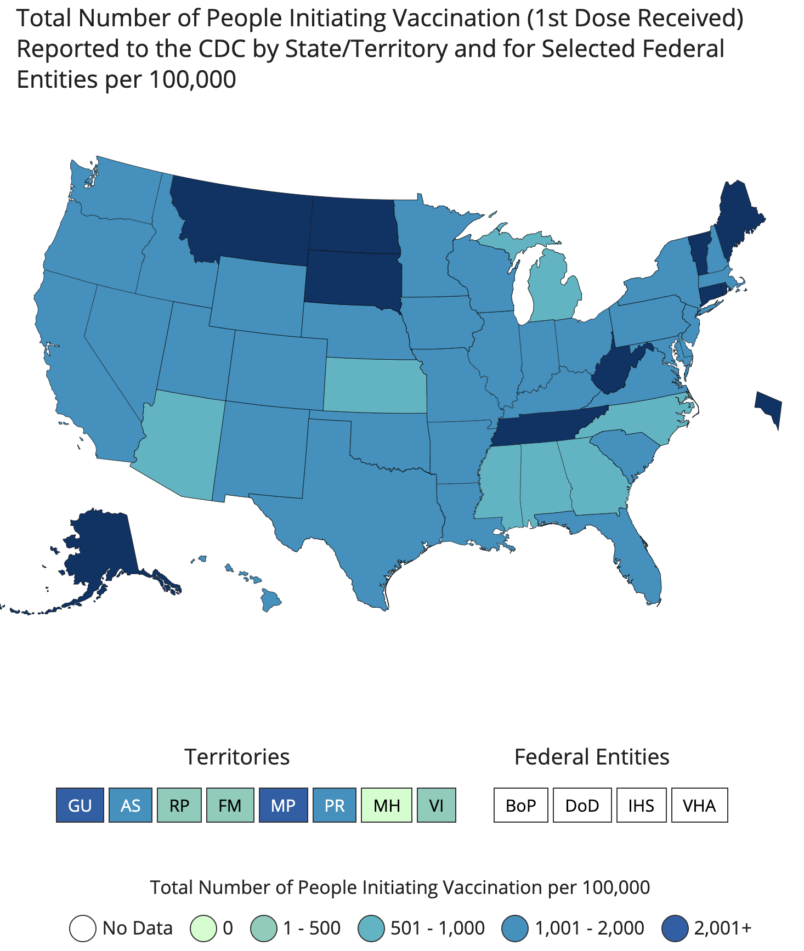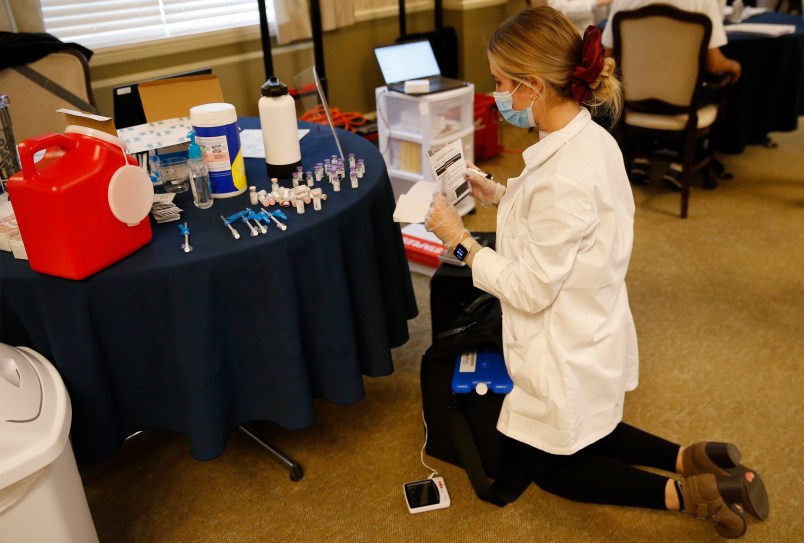It’s becoming increasingly clear that it will be many months until the U.S.’s COVID-19 vaccination campaign reaches the general public, as government data shows severe delays in the effort amid a lack of planning by the Trump administration.
The country has managed to distribute 15.4 million doses of the COVID-19 vaccine as of this writing, according to CDC data. But distributed is different than getting shots into arms: only 4.5 million Americans have received their first dose.

That pales in comparison to the 20 million that Trump officials had promised would be vaccinated by the end of last year, and will add months to the amount of time it will take for the pandemic-ending shot to be available to the general public.
The data is provisional, and subject to change. Experts say that vaccination rates could increase in the coming weeks thanks to the end of the holidays, kinks getting smoothed out in distribution systems, and $8 billion appropriated by Congress last month for the effort to vaccinate the country.
But even amid that optimism, the numbers do not look good.
Millions behind
In Los Angeles, Mayor Eric Garcetti said on Sunday that “we are at a pace right now to deliver vaccines in L.A. over five years, instead of over half a year.” And in New York State, Gov. Andrew Cuomo (D) on Monday threatened to fine hospitals that held on to vaccine doses for longer than seven days in a desperate bid to speed up the process.
“We are not where we want to be, there’s no doubt about that, but I think we can get there,” Dr. Anthony Fauci said on Sunday, saying that the country should target 1 million vaccinations per day. Were the country to bring inoculating one million people each day tomorrow — and assuming that everyone would want to receive the vaccine — the entire U.S. population could be vaccinated by December 2021.
Top Trump officials have said that vaccine could be as available as the seasonal flu shot by March — a claim that’s undercut by current vaccination rates and contradicted by those working on Operation Warp Speed, the government’s vaccine program, who say that summer 2021 could be a more realistic timeframe for that level of availability.
“We would love to have the ability to reach the majority of Americans by the end of second quarter 2021, that’s what many had initially predicted,” said Dr. Leana Wen, a former Baltimore public health commissioner. “To reach that, we need to be vaccinating 3.5 million Americans a day — we’re currently at a million a week.”
State officials are trying to vaccinate their populations amid a total lack of coordination by the Trump administration and, until recently, a significant lack of funding from the federal government. Disorganization has led to stories of doses going to waste, while at least one pharmacist reportedly gave doses out randomly before they expired.
Playing catch-up
The first vaccinations in the U.S. began on Dec. 14 — 20 days ago. Since then, the country has seen vaccinations occur at a rate of around 200,000 per day. That’s occurred under the relatively easy conditions of phase 1A — in which vaccines are reserved for health-care providers and nursing home residents and staff.
Since then, the distribution effort has been mired in delay and confusion, including one mid-December episode in which Pfizer claimed that it had millions of doses sitting in its warehouse.
But the vaccination rate has increased over the past few days, Fauci said, noting that after a holiday lag in reporting, the number of Americans vaccinated went up by 1.5 million over the past three days as states scramble to make up for time lost in December.
“It’s a slower start than we’ve expected, and states still have to catch up on giving people the doses that they have on hand,” Josh Michaud, an epidemiologist at Kaiser Family Foundations, told TPM. “That’s the task immediately before the states — get those priority populations vaccinated with the doses on hand.”
Kaiser estimates that phase 1A contains around 17 million people, suggesting that 13 million Americans still need to be vaccinated before the shots open up to other groups of people. Per the current rate of 200,000 per day, that suggests weeks before the doses become available to the next category of people.
That will likely present the state public health departments running the vaccination campaign with even greater problems. In Oklahoma and Florida, states that elected to make vaccines available to the most vulnerable via a first-come first-serve basis, the elderly camped out for hours overnight in their cares waiting for the shot.
President Trump and other White House officials have rejected any notion that he or they are responsible for the botched rollout, saying that it’s a states issue.
Some States are very slow to inoculate recipients despite successful and very large scale distribution of vaccines by the Federal Government. They will get it done!
— Donald J. Trump (@realDonaldTrump) January 2, 2021
But Garcetti, the LA mayor, likened the situation to having vaccine doses dumped on them without instruction or help on what to do.
“The federal government can’t tell the local governments and state governments to do something and not give us aid,” he said.







GOP feature, not bug. Kill off as many POC as possible.
Trumpers thought they’d be clever and hang Biden with a poor second wave of vaccinations, but fucked up the first wave.
You can’t get logistics from a blockhead Charlie Brown.
The one thing saving those of us among the general public who desperately want the vaccine is that so many are refusing it. Refuse away. That just bumps me up in line.
Operation Clusterfuck